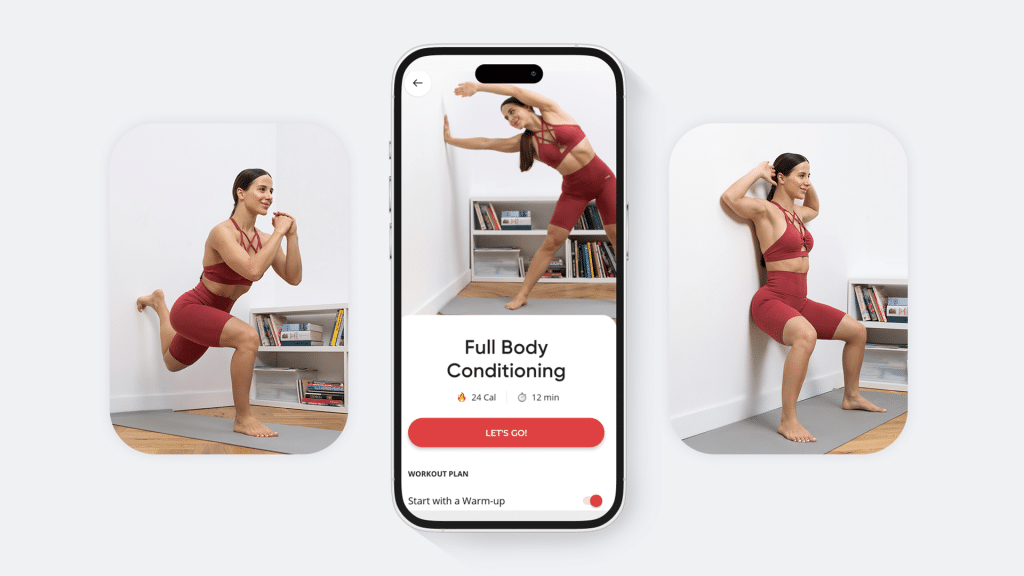According to the Academy of Orthopaedic Surgeons (AAOS), back pain is a common condition that affects a significant number of adults worldwide (3). It can stem from various factors, such as poor posture, excessive sedentary behavior, or muscle strain.
Upper-back pain can be particularly difficult to live with. The tension and discomfort associated with it can make everyday activities such as sitting, standing, and walking quite difficult.
Severe cases may require medical intervention, but mild back pain often responds well to regular stretching. However, it’s essential that you perform these stretches correctly to maximize the benefits and prevent further harm.
We’ll explore eight upper-back stretches that aim to alleviate discomfort and enhance flexibility. Some of these stretches are yoga-based and others are more traditional. At their very core, they all serve the purpose of stretching and strengthening the affected muscles.
Lean and toned up body isn’t just a far-fetched fantasy. Check out the BetterMe app and watch it propel your weight loss journey into high gear!
What Causes Upper-Back Pain?
Upper-back pain can be caused by a variety of factors, some of which are directly linked to muscle anatomy, mechanics, and movements. Here are six potential causes:
Poor Posture
Persistent slouching or hunching, particularly if you work at a desk or use mobile devices often, can result in unnecessary strain on the upper-back muscles. Over time, this straining can cause discomfort and pain in the upper-back region.
Muscle Overuse
Engaging in repetitive activities or overexerting yourself during exercise can cause muscle strain in the upper back. This overuse can cause small tears in the muscle tissues, which results in discomfort and inflammation.
Injuries or Trauma
Accidents such as falls, car crashes, or sports-related traumas can cause sprains, fractures, or muscle damage in the upper-back area. These injuries often cause acute and sometimes persistent discomfort.
Muscle Imbalance
Muscular imbalances occur when certain muscles become weak or overly tight, which causes an imbalance in the upper back. For example, weak deep neck flexors can result in increased strain on the upper-back muscles, which leads to pain. Muscle Imbalances may result from a lack of exercise, poor posture, and/or overuse.
Arthritis
Osteoarthritis can cause inflammation in the joints between the vertebrae and the ribcage, which can cause pain in the upper-back region. This type of arthritis is common among people of advanced age (7).
Stress or Anxiety
Unmanaged stress and/or anxiety can cause tension in the upper-back muscles. This tension may result in muscle fatigue and pain, in addition to tightness in the area (8).
How Do You Stretch Out Your Upper Back?
Stretching your upper back involves various exercises that allow you to loosen the muscle fibers and increase flexibility, which will relieve muscle tension and reduce discomfort. You require exercises that extend, flex, or twist your upper spine, together with deep, slow breathing to facilitate muscle relaxation.
Before we dive into our list of 8 upper-back stretches for pain relief, we should mention that these exercises need to be performed in a slow, controlled manner to ensure injury is avoided. It’s important to remember that the goal is to stretch the muscle fibers, not to strain them further.
Stretch 1: Cat-Camel Stretch
Originating from yoga, this exercise is one of the best upper-back stretches for pain. It works by actively flexing and extending the spine, which helps relieve tension in the back muscles.
- Start on all fours with your hands under your shoulders and your knees under your hips
- Slowly arch your back and lift your chest and sitting bones toward the sky
- Round your back, tuck in your tailbone, and drop your head toward the floor
- Repeat these movements 10-15 times
Stretch 2: Thoracic Extension
A thoracic extension is an excellent upper-back stretch between the shoulder blades. It targets the rhomboid muscles, which are often tight and overworked if you maintain poor posture.
- Sit on the edge of a chair with your feet flat on the ground
- Clasp your hands behind your neck
- Slowly lean back over the top of the chair, extending your spine while looking up at the ceiling
- Hold this position for a few seconds, then return to the starting position
- Repeat this movement 10-15 times
Stretch 3: Supine Twist
This upper-back stretch in bed targets the upper and middle back muscles, which allows for a gentle wake-up routine or a relaxing pre-sleep activity.
- Lie on your back on your bed
- Pull one knee toward your chest, keeping the other leg straight
- Slowly twist your lower body to the side, aiming to touch your knee to the bed while keeping your shoulders flat
- Hold this position for 20-30 seconds before switching sides
- Repeat this stretch 3-5 times on each side
Read more: 12 Back Exercises for Women Who Want To Build Muscle.
Stretch 4: Shoulder Rolls
Shoulder rolls are another effective upper-back stretch after a workout. They help relax the trapezius muscles, which can become tense from lifting or other upper-body exercises.
- Stand or sit with your back straight
- Lift your shoulders up toward your ears, then roll them back and down
- Repeat this in a circular motion 10-15 times
- Reverse the direction of the rolls, moving your shoulders forward
- Repeat this another 10-15 times
Stretch 5: Wall Angels
Wall angels are effective upper-back stretches for posture correction. They can help strengthen the upper-back muscles while also promoting improved postural alignment.
- Stand with your back against a wall and your feet hip-width apart
- Bend your arms at a 90-degree angle and press them against the wall
- Slowly move your arms up and down like a snow angel
- Perform this movement 10-15 times
Stretch 6: Chest Opener
Are you wondering how you can stretch the upper-middle back to improve your posture? Try the chest opener stretch. It helps counteract the forward-leaning posture many of us adopt while we work.
- Stand up straight with your feet hip-width apart
- Interlock your fingers behind your back
- Gently pull your hands away from your back while lifting your chest and looking upwards
- Hold this position for 20-30 seconds and repeat 5-10 times
Stretch 7: Scapular Squeeze
The scapular squeeze is an effective stretch for upper-back knots. It targets the rhomboids and trapezius, which releases tension and improves mobility.
- Stand or sit with your back straight
- Pull your shoulder blades together as if trying to hold a pencil between them
- Hold for 10 seconds, then release
- Repeat this exercise 10-15 times
Stretch 8: Seated Twist
The seated twist is an easy and effective somatic stretch that can be performed in any chair. It will help quickly relieve upper-back pain and also release tension in the lower back.
- Sit on a chair with your feet flat on the floor
- Slowly twist your torso to one side, using your hands on the armrests for support
- Hold this position for 10-20 seconds before switching sides
- Repeat this stretch 3-5 times for each side
BetterMe app is a foolproof way to go from zero to a weight loss hero in a safe and sustainable way! What are you waiting for? Start transforming your body now!
Should You Stretch Your Upper Back If It Hurts?
Stretching can be beneficial for relieving tension and improving flexibility in the upper back, but it should be done correctly and at the appropriate time to avoid worsening the discomfort.
Here’s a comprehensive guide to when it’s okay to stretch your upper back if it hurts:
- During Physical Therapy: Under the guidance of a physical therapist, stretching can be both safe and beneficial. These professionals are trained to help you perform exercises correctly, which minimizes the risk of further injury.
- Mild to Moderate Pain: If your upper-back pain is mild to moderate and is not caused by a severe injury, light stretching can help ease the tension. It’s important to listen to your body and stop immediately if the pain becomes more intense.
- Post-Workout: Stretching after working out can help prevent muscle stiffness and soreness. This is particularly true if your workout involves upper-body exercises that strain the back muscles.
- Chronic Pain: For those who are dealing with chronic upper-back pain, regular, gentle stretching such as chair stretches can help manage the pain levels. A physiotherapist can help create a safe and effective stretching regimen.
- Pain Due to Poor Posture: Upper-back pain that results from poor posture can often be alleviated by stretching exercises that promote better alignment and strengthen the back muscles. Wall angels and scapular squeezes are particularly effective for this.
You should avoid stretching out your upper back if:
- You have an acute injury, such as a sprain or strain
- The pain intensifies when you attempt to stretch the affected area
- You experience dizziness, lightheadedness, or any other unusual symptoms when stretching
- You experience pain that radiates beyond the upper-back region
- Stretching intensifies the symptoms of any underlying medical conditions
- You cannot perform the stretch with good form
A good rule of thumb is to always wait until the pain has subsided before you attempt any stretches.
Furthermore, stretching in the correct way, with proper form and technique, is essential for obtaining the best results with minimal injury risk. You should assume your form is off if:
- You cannot feel the muscle you are trying to stretch
- You experience any numbing, tingling, or burning sensations in the area you are stretching
- You experience pain in your joints while stretching
- There is an excessive amount of tension or discomfort while you perform a stretch
- You have difficulty holding the stretch for at least 15 seconds
You should listen to your body and stop immediately if you experience any of the above sensations or any discomfort while you are stretching. Instead, you should focus on performing each stretch with slow, controlled movements and maintain a relaxed posture. This will help ensure that you maximize your upper-back stretches safely and effectively.
What Helps Tight Upper-Back Pain, Other Than Stretching?
In addition to stretching, there are other measures you can take to relieve tight upper-back pain. Here are some of the most effective strategies:
- Rest: The body needs time to heal and rest is one of the best ways for it to do this. Taking periods of rest during activities such as work or exercise can help reduce muscle tension and improve upper-back flexibility.
- Massage: Massages can help gently break up tight knots in the muscles and improve circulation, which will relieve discomfort in the upper-back area (4). A professional massage therapist is recommended.
- Hot and Cold Compress: Both hot and cold compresses can be used to reduce upper-back pain. The application of a warm compress can help relax strained muscles, while a cold compress can help reduce inflammation (5).
- Meditation: Practicing mindful meditation or yoga will help reduce stress and may relieve tension in the body, which may make back pain more bearable (2).
- Exercise: Regular exercise strengthens the muscles in the back, helping to improve posture and reduce discomfort (1). Low-impact activities such as swimming and cycling are particularly recommended.
- Postural Correction: Poor posture can be a major contributor to upper-back pain, so it’s important to ensure you sit up straight with your shoulders rolled back. Regularly checking your posture throughout the day can help maintain correct spinal alignment (6).
Read more: Keep Your Back Squat Muscles Worked With The Right Technique.
Frequently Asked Questions
Why does my tight upper back hurt?
Tight upper-back pain is often a result of muscle tension or strain, generally due to poor posture, overuse, or lack of exercise. This tension can lead to discomfort and, in some cases, pain.
How do you loosen tight upper-back muscles?
To loosen tight upper-back muscles, apply a combination of targeted stretches, physical activity, and relaxation techniques. Activities such as yoga and swimming, in addition to regular breaks from long periods of standing or sitting, can be particularly helpful.
Why does my upper back hurt between my shoulder blades?
Pain between your shoulder blades can be due to a variety of reasons, such as muscle strain, herniated discs, or poor posture. It could also be a result of overuse, such as repetitive movements during sports or work.
Workouts and stretches that target the shoulders should help ease the pain. To work out the shoulders, you should incorporate exercises such as shoulder circles, seated twists, and chest expansion stretches into your exercise routine.
Why are the muscles in my upper back so tight?
The muscles in your upper back may become tight due to factors including poor posture, stress, or prolonged periods of sitting or standing. In certain cases, tightness can also be the result of an underlying health condition.
Should I massage a pulled upper-back muscle?
While a gentle massage can help alleviate muscle tension and promote healing, it’s advisable to consult a healthcare professional before massaging a pulled upper-back muscle, as this may worsen the injury if performed incorrectly.
How should I sleep with upper-back pain?
If you’re experiencing upper-back pain, you should try sleeping on your back using a pillow to support your neck and maintain spinal alignment. You should avoid sleeping on your stomach, as this can cause additional strain on the upper back.
The Bottom Line
Upper-back stretches are a gentle, effective way to relieve tightness and pain in the upper back. You should ensure that you use correct form and technique, in addition to considering any underlying medical conditions while stretching. In addition to stretching, other measures such as massage, exercise, posture correction, and relaxation can help alleviate upper-back discomfort.
DISCLAIMER:
This article is intended for general informational purposes only and does not serve to address individual circumstances. It is not a substitute for professional advice or help and should not be relied on for making any kind of decision-making. Any action taken as a direct or indirect result of the information in this article is entirely at your own risk and is your sole responsibility.
BetterMe, its content staff, and its medical advisors accept no responsibility for inaccuracies, errors, misstatements, inconsistencies, or omissions and specifically disclaim any liability, loss or risk, personal, professional or otherwise, which may be incurred as a consequence, directly or indirectly, of the use and/or application of any content.
You should always seek the advice of your physician or other qualified health provider with any questions you may have regarding a medical condition or your specific situation. Never disregard professional medical advice or delay seeking it because of BetterMe content. If you suspect or think you may have a medical emergency, call your doctor.
SOURCES:
- Effect of an exercise program for posture correction on musculoskeletal pain (2015, ncbi.nlm.nih.gov)
- Effectiveness of mindfulness meditation on pain and quality of life of patients with chronic low back pain (2015, ncbi.nlm.nih.gov)
- Low Back Pain (2021, orthoinfo.aaos.org)
- Massage therapies (2002, ncbi.nlm.nih.gov)
- Mechanisms and efficacy of heat and cold therapies for musculoskeletal injury (2015, pubmed.ncbi.nlm.nih.gov)
- Posture (n.d., physio-pedia.com)
- Primary Osteoarthritis (2022, ncbi.nlm.nih.gov)
- Stress effects on the body (2023, apa.org)










